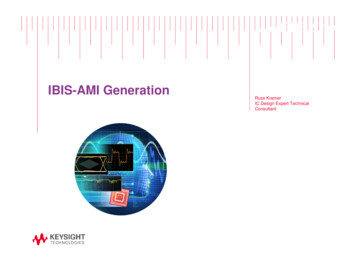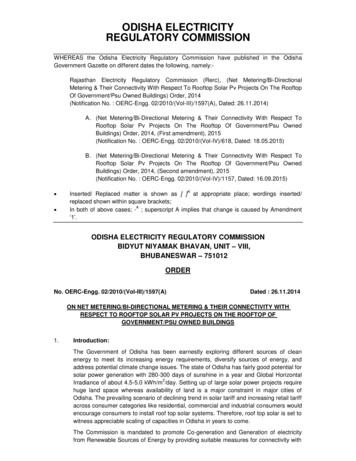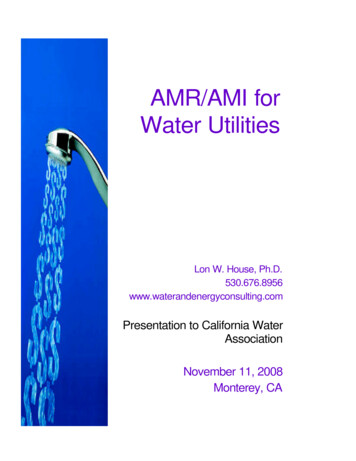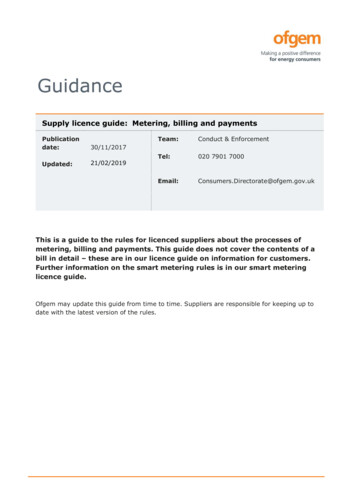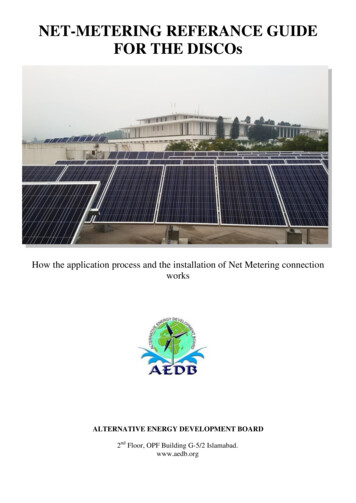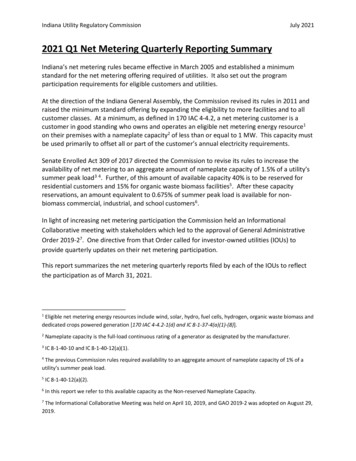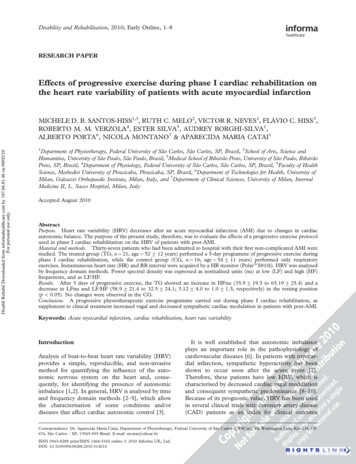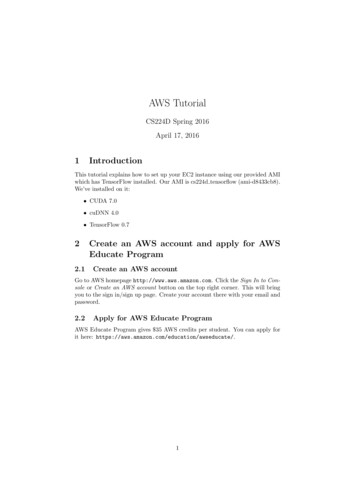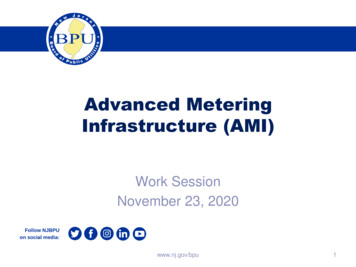
Transcription
Advanced MeteringInfrastructure (AMI)Work SessionNovember 23, 2020www.nj.gov/bpu1
Opening Remarks:Heather Weisband,Senior Counsel, New Jersey BPUwww.nj.gov/bpu2
Education:Chris VillarrealPlugged In Strategieswww.nj.gov/bpu3
Advanced MeteringInfrastructure Work SessionBefore the New Jersey Board of Public UtilitiesDocket No. EO20110716Chris VillarrealPlugged In StrategiesNovember 23, 2020
Topics for Discussion What is AMI Data Access and Data Privacy U.S. Department of Energy report on AMI
Conversations are occurring across the U.S. On-going proceedings in Minnesota (AMI and Data) New Hampshire (Data) Arkansas (Data) Michigan (Data) New York (Data) Connecticut (AMI and Data) Maryland (Data) New Mexico (AMI) Virginia (AMI) Hawaii (Data)According to EEI, close to 70% of US customers will have AMI by 2021
AMI“Advanced metering infrastructure (AMI) is an integratedsystem of smart meters, communications networks, and datamanagement systems that enables two-way communicationbetween utilities and customers. Customer systems includein-home displays, home area networks, energy managementsystems, and other customer-side-of-the-meter equipmentthat enable smart grid functions in residential, commercial,and industrial facilities.”https://www.smartgrid.gov/recovery act/deployment status/sdgp ami systems.html7
More about the meter Depending on utility needs, digital meter collects and stores kwh readingsbetween 15-60 minutes. Usually transmits the data back to the utility a couple times a day Meter can collect more than just kwh! Meter monitors kw, current, volt, var, toname a few. Access to this information often restricted by the utility for Business reasons Meter memory and processing Communication network bandwidth8
Even more! Meter usually comes with 2 radios First radio (900 Mhz) is to communicate back to the utility (over a mesh network) Second radio (2.4 Ghz) is to communicate locally into the home9
Home Area Network (HAN) Smart Meters come with two radios One to send information back to the utility One to send information into customer premiseHAN radio capable of sending informationevery 7 seconds Usage Other meter dataRequires Zigbee-certified (IEEE 2030.5) equipment Router In home displayHAN can provide usage, rate, and cost informationreceived from meter and utility via AMI network
11
Data Access and Data Privacy
Definitions Customer Energy Usage Data Primary Purpose The use of Account Data or CEUD that is reasonably expected by the customer: (1) toprovide or reliably maintain customer-initiated service; and (2) including compatibleuses in features and services to the customer that do not materially changereasonable expectations of customer control and third party data sharing.Secondary Purpose Customer Energy Usage Data reflects an individual customer’s measured energyusage but does not identify the customer.The use of Account Data and CEUD that is materially different from the PrimaryPurpose and is not reasonably expected by the customer relative to the transactionsor ongoing services provided to the customer by the Service Provider or theircontracted agent.Comes from DataGuard documentation
DataGuard Began in 2012 Representatives included utilities, state commission staff, third parties, andprivacy experts Met several times through 2015 Final document released January 2015 Resulting document set of voluntary principles High level in nature Provides guidance Applies to utilities and third nloads/DataGuard VCC Conceptsand Principles 2015 01 08 FINAL.pdf
Core Principles Consumer Notice and Awareness: Customers shouldbe given prior notice about privacy-related policiesand practices. Customer Choice and Consent: Customers shouldhave a degree of control over access to their ownCustomer Data. Customer Data Access and Participation: Customersshould have access to their own Customer Data andshould have the ability to participate in itsmaintenance. Integrity and Security: Customer data should be asaccurate as reasonably possible and secured againstunauthorized access. Self-Enforcement Management and Redress:Enforcement mechanisms should be in place toensure compliance with the foregoing principles.
Framework for Data Privacy All adopted Frameworks have similar requirements Notice Purpose Statement Access and Control Data Minimization Use and Disclosure Limitation Data Quality and Integrity Data Security (including breach notification) Accountability and AuditingMany frameworks are organized around the Fair Information Practice Principles,developed by the FTC in the 1970s, and later adopted by DHS. See- y policyguide 2008-01.pdf “ this decision adopts the FIP principles as the framework for developing specificregulations to protect consumer privacy ” California PUC, D.11-07-056 (July 2011)http://docs.cpuc.ca.gov/word pdf/FINAL DECISION/140369.pdf
Data Access Privacy and data access often viewed as in conflict- but it doesn’t have to bethis way Control in the hands of the customer Utility (or 3rd Party) is custodian Identifiable Customer UsageNon-Identifiable Aggregated AnonymizedProcess and formats must be consistent across utilities Standards (NAESB REQ 21/Green Button) Risk based approach Differential aggregation
California Example California PUC Adopted July 2011 (D.11-07-056) Based on Fair Information Practice Principles Applies to utilities, utility contractors, and thirdparties that obtain data from the utilities To be enforced via utility tariffs Goals of rules are both to protect customer privacy, but also enable customers to access usagedata and share that data with authorized third parties to promote future conservation and gridmanagement activities Primary Purpose/Secondary Purpose structure Primary purposes are provision or billing of electricity or gas, provide for system,grid, oroperational needs, provide services required by state or federal law or as directed by the CPUC,and “plan, implement, or evaluate” demand response, energy efficiency or energy managementprograms Secondary purpose is anything that is not a primary purpose Primary Purposes do not require customer consent With roll-out of gas AMI, also applies to gas only utility (Southern California Gas) https://www.pge.com/en e
California Data Access Requirements All three electric IOUs should make information available to customers in aconsistent manner. Provide customers with approximate electricity price, actual usage and billestimate, updated daily. Also provide bill-to-date, bill forecast data, projected month-end tiered rate,and notification of crossing tiers; all prices should be “all in” price forelectricity. Utilities must allow third party access via the utility’s back-haul whenauthorized by a customer. Directs utilities to develop a process to allow customers to utilize the HomeArea Network to access meter data Created process to allow certain groups access to more granular data, such asuniversities and local governments Tariffs in machine-readable format
Green Button Standards-based means of providing usage data to customer authorized thirdparties Standard capable of providing wide variety of data, e.g., voltage, billing cycles, gas,water Developed starting in 2011 with California utilities Green Button Download File format with all metering data Customer provides file to third partyGreen Button Connect Customer authorized third party obtains data directly from utility Based on delivery of AMI data, but can use any level of granularity Note- EDI a separate means of providing data, largely in the retail choice context. Not a “competitor,” but another standard suited for a different purpose
Aggregation examples For most applications, 15/15 is often designated Any aggregation must have at least 15 customers and no one customer is more than 15% of theload Used for residential mostlyFor industrial, see 4/80 Must have 4 customers and no one customer is more than 80% of the loadAggregation is a function of time (15 minutes, hourly, daily, monthly, quarterly, annually) Geography (zip 4, zip, census block, city, county, state) Groupings (Residential, Commercial, Industrial)Trade off between value and privacy Annual state data, kind of useful, but privacy protected Hourly residential on feeder, very useful, but privacy at riskDifferential Aggregation Adds noise to data to limit ability to re-identify a customer
U.S. Department of Energy Report:AMI In Review: Informing the Conversation
Effort OverviewObjective: Investigate how investments are being evaluated, determine if there wasadditional data or information that would be helpful, and explore the impact of new gridmodernization technologies on the regulatory process.Phased research study with two components Analysis of public records: Reviewed more than100 AMI applicationsUnderlying Goals Convene stakeholders: Spoke with over 125 individualsfrom over 50 entities representing commissions, utilities,customer advocates and third partiesAim of effort Provide insights and perspectives on how AMIapplications are being developed and evaluated NOT seek to offer an opinion on state actions or toadvocate for or against any position.231. Create valuable resourcefor industry2. Help bridge perspectives3. Identify opportunities forsuccess4. Illuminate the evolvingnature of regulatoryproceedings
Resulting ReportsMain Report Captures the collective insights and perspectives of participants Organized around five main chapters related to approach, analysis factors, discussion of benefits,collaboration and transparency, and customer interaction with the technology Includes helpful resources, list of elements to consider and questions that might be asked whendeveloping or evaluating an investment proposalCompendium Reference materials of 600 filings from over 230 proceedings Includes filing document details and entity review notesA neutral perspective that informs new and experienced practitioners about thevast and complicated questions surrounding an AMI regulatory review24
Conversation Findings and Observations Increased review scrutiny due to inconsistent implementation results Value is being left on the table Lack of a sufficient record hampers approval and increases frustration AMI is a big project that needs a multidisciplinary team with executivesupport CBA is a decision tool and is not necessarily ameans in and of itself Pre-application stakeholder processes can bevaluable but depends on approach AMI Investments funded through ARRA havehad mixed results in informing regulatoryproceedings25
Approaching the FilingFour major elements that commissions and parties are looking forThe vision A well-articulated vision and transparency about future investments can help alleviate concerns Raises questions for utilities about the right balance and how much to includeCustomers at the forefront Make a direct connection to the customer – don’t rely on thecommission to infer or hear it during exploratory questionsSufficient detail to support the record A proposal needs to stand on its own merits even if thecommissions is favorable to the technologyCommitments and accepting risk Perspective differs between the various parties Well-defined metrics and additional reporting can give commissions and advocates confidence and level-setexpectations Underscored by the analysis - settlement agreements typically included provisions that bound the utility to specificcommitments regarding timelines and AMI functionality26
Collaboration and TransparencyA collaborative stakeholder process with two-way dialog can increaseunderstanding, bridge perspectives, instill confidence, and foster trust Parties increasingly want more details and a voice in the programs and valuestreams a utility might pursue Hearing from engineers about the technology and potential limitations integrating withlegacy systems can be important for understanding utility choices and stakeholderviewpoints Helps think through value from all perspectives Agreement on all areas is a lofty but unlikely goal Demeanor matters – a formal demeanor can stifle impressions of openness and thefree-flow of information Who manages the process can make a difference Mitigate surprises through continued collaboration. Don’t necessarily limit thestakeholder process to pre-approval or an AMI deployment27
AMI Analysis Review often includes two components Specific cost-benefit analysis Technical review A positive cost-benefit analysis is not necessarilyenough Commissions and advocates are looking for details,a timeline for realizing benefits, and what it will take to achieve the benefit Technical details help regulators understand the functionality so they can determineif the investment will perform as described and accomplish utility and state goals Providing details can address concerns about cost recovery, obsolescence, and usefullife of the asset Parties emphasized the importance of achieving benefits for customers sooner rather than later28
Presentation of Cost and Benefits The majority of benefits identified in utility applications were operational benefitswith no stated connection to the customer – over 70% on average Operational benefits may be easier to quantify Think about benefits – even operational benefits - through the lens of the consumer(e.g., predictive maintenance can reduce unplanned outages and decrease customerfrustration) Intangible benefits can be a significant factor and can tip the scale positive Customers are not homogenous and will prioritize value differently. Focus groups canhelp demonstrate an understanding of which programs hold the most value for differentcustomers. Some benefits might not be cost effective to achieve Don’t forget about benefits that may accrue to the market(and thus customers) – regulators, advocates and othersare interested in these29
Interaction Between AMI & the Customer AMI is expanding the commission’s and advocates’ views of value to beyond whatcan be achieved with utility programs Assessment weighs the cost-effectiveness for consumers, whether a utility ora third-party product or service Four broad classes of issues were most prominent Can derail utility applications if not addressed. Often require lengthy conversations Increased sensitivities around these topics resultbecause projected savings or benefits often dependon customer programs and participation creating arelationship between the customer and the AMI system Customer education plan is important In more than 20 settlement agreements, elementsof the customer engagement plan were addressedas stipulations within the agreements in nearly every oneFour broad classesof issues:1. Enabling customercapabilities andtechnology2. Customer choice andopt-out3. Impacts to vulnerable ordisadvantagedcustomers4. Education andengagement30
Moving Forward“What impact will AMI have on the customer experience?” AMI is an early indicator of how the review process is changing Customer-centric view of value that is not limited to what utility can provide Role of the commission is changing too requiring more knowledge of thetechnical details Commissions must have a record with sufficient detail on which it canissue a decision Collaboration is becoming an essential component Benefits are being replaced with capabilities
Thank you!Chris VillarrealPlugged In Strategieschris@pluggedinstrategies.com
Panel 1:Ensuring AMI’s Ability to Facilitate EMP Goals:An Exploration of Hardware and SoftwareConsiderationsModerator: Paul Flanagan, Executive Director, NJ Boardof Public Utilities11/20/2020www.nj.gov/bpu33
Panel 1: Paul Flanagan, Executive Director, New Jersey Boardof Public Utilities› Gregg Edeson, PA Consulting› Robert Gibbs, Centrica› Marissa R. Hummon, Utilidata› Nha Truong, American Waterwww.nj.gov/bpu34
AMI Use Cases as a basis for achieving EMP GoalsGoalsCustomerBenefitsExample Use CasesTech. RequirementsCustomer Engagement &CommunicationsSmart MetersCustomer Energy EfficiencyUtilityOperationsCustomer DER, EV, PVCommunicationInfrastructureAsset Load Phase Management,Balancing & Power AnalysisSystemIntegration (OMS,Billing, etc.)Distribution Technical & NonTechnical LossesSocial &EnvironmentalGoalsMDMSInnovative Rate DevelopmentMobile / WebCustomer Portals PA Knowledge Limited PA Confidential – Internal use only1
Panel 1: Paul Flanagan, Executive Director, New Jersey Boardof Public Utilities› Gregg Edeson, PA Consulting› Robert Gibbs, Centrica› Marissa R. Hummon, Utilidata› Nha Truong, American Waterwww.nj.gov/bpu36
AMI, TPS, and the EMP:Perfect TogetherRob GibbsCentricaNovember 23, 2020
Benefits of AMI AMI systems and the data retrieved can enable:– Improved Grid Operations by providing greater awareness of what’s going on in thedistribution system so EDC’s can proactively solve problems This can lead to greater resiliency and outage management– Better integration of Distributed Energy Resources (“DER”) through data analytics This means utilizing resources like solar, wind, and battery technologies in the mostefficient manner and in a way that protects the reliability of the grid system– A growing suite of customer services like online access to energy use information,high usage alerts, power outage alerts, remote connect/disconnect services andmany more This provides customers with information that can help them use less energy, savemore , manage their behaviors that impact energy use, and conduct routinetransactions seamlessly– Innovative pricing by EDC’s or third party suppliers that rewards customers forvoluntarily reducing energy consumption during peak electricity demand therebyprotecting the grid system from power outages and other impacts This helps save customers by rewarding customers who make smart energyusage decisions38
AMI and TPS What AMI with a Data Access Plan (“DAP”) can enable for TPScustomers who consent to share their data:– Time of Use offers - Ability to charge a free or discounted rate at specific times.Examples include: Free Weekends, Free Nights, Free Month, On-peak / Off-peakdiscounted rates. Customers can select a plan that best fits the needs of their family withthese types of offers.– Prepaid - Similar to cell phone plans, can prepay for electricity. Customers get chargedtheir usage on a daily basis and their balances are refreshed as needed. They receivetext messages with their usage so they can adjust their usage patterns as needed. Also,allows customers that don’t have sufficient credit to start with a prepaid offer.– Demand Response - Customers can sign up to received demand response textmessages where the TPS advises them to reduce their usage during peak / costly times.If they are able to respond and reduce their usage by x%, they qualify for a bill credit.– Flat Bill - Product that offers a flat monthly fee unless usage goes over xx kwh. While theESCO doesn’t need smart meter data for this necessarily, it helps with retention producttargeting (see below) if the TPS can understand the customer’s on peak / off peak usagebehavior to determine a flat bill price right for them.– Retention Product Targeting - Smart meter data allows us to understandcustomer usage patterns and target them with products that makes sense for them,especially for time of use and flat bill offerings.39
AMI and TPS cont.– Value add services - By monitoring smart meter data at potentiallythe appliance level, the TPS can alert customers of excessive usageor problems with an appliance.– Smart alerts - Many Texas customers receive Smart alert emails –these emails summarize usage halfway through the month andprovide an estimated monthly bill for customers so they haveadvanced idea of their bill size and can adjust their usage behavior ifneeded.– Real-time energy pricing product - Allows customers to receivewholesale energy pricing at the hourly level with no adders for amonthly fee.40
So how does this help NJ’s EMP? TPS AMI enabled products and services can help NJ achieve almostevery Strategy laid out in the EMP:– EV TOU rates and charging infrastructure to speed adoption of EV’sand electrify the transportation sector (Strategies 1 and 3)– Solar and energy storage products for residential/C&I to decarbonizethe building sector (Strategies 2 and 4)– Empower customers energy management through ownership andcontrol of their data, including sharing with TPS (Strategy 5) An example of that would be customers with EVs and battery storagemay be able to optimize their peak and off-peak usage– Community Solar and energy aggregation programs for LMIcommunities (better data allows for better pricing)(Strategy 6) but only if a DAP is in place at the time of smart meter deployment!41
Bottom line There are no justifiable barriers to inclusion of a DAP in any AMIdeployment plan. Competitive states with AMI have or are rolling out DAPs as part of theirAMI deployment (PA, IL, OH, NY) New Jersey should not, once again, be at the bottom of the list of stateswho do not have a DAP in place at the time of AMI deployment. New Jersey can borrow from these states’ experiences and existingregulations to develop a DAP quickly and with the customer in mind.42
For more informationRob GibbsDirector – Corporate & Regulatory 9-0233
Panel 1: Paul Flanagan, Executive Director, New Jersey Boardof Public Utilities› Gregg Edeson, PA Consulting› Robert Gibbs, Centrica› Marissa R. Hummon, Utilidata› Nha Truong, American Waterwww.nj.gov/bpu44
About UtilidataWe are the market leader inmeter-based software withover a decade of experienceoptimizing the distributiongrid.45Confidential- Please do not distribute.Copyright 2019 Utilidata, Inc. All Rights Reserved
AMI can provide real-time visibility and control ofthe grid-edge, if equipped with the right softwareNew meters should come equipped with basic capabilities:1. Real-Time Data Insights: On-meter computation that distills important information in real-time, like lowvoltage conditions or changes in power quality2. System Visibility: Provide real-time power flow modeling all the way to the meter3. Price Signals: Communicate TOU rates and other price signals to smart devices (e.g., thermostats),service providers and customers4. Local Optimization: Identify the value of loads, storage and on-site generation and make optimizationdecisions/recommendations for both the grid and DERs in service of lowest-cost operations andmaintaining service in an outage5. Anomaly Detection: Enable predictive detection of anomalies to prevent outages, fire hazards or securitybreaches46
Meeting the goals of the Energy Master Plan willrequire real-time visibility and control of the grid-edgeStrategy 1Reduce energy consumption and emissions from the transportation sectorStrategy 2Accelerate deployment of renewable energy and distributed energy resourcesStrategy 3Maximize energy efficiency and conservation and reduce peak demandStrategy 4Reduce energy consumption and emissions from the building sectorStrategy 5Decarbonize and modernize New Jersey’s energy systemStrategy 6Support community energy planning and action with an emphasis on encouragingand supporting participation by low- and moderate-income and environmentaljustice communitiesStrategy 7Expand the clean energy innovation economy47
Initial approval is where the path for AMI is set andwhere outcomes and capabilities should be specified4321Meter-to-cash; TOU rates; ping meter during an outage48
Panel 1: Paul Flanagan, Executive Director, New Jersey Boardof Public Utilities› Gregg Edeson, PA Consulting› Robert Gibbs, Centrica› Marissa R. Hummon, Utilidata› Nha Truong, American Waterwww.nj.gov/bpu49
Panel 2:Data Access, Sharing, and TransparencyModerator: Abraham Silverman, General Counsel, NJBoard of Public Utilities11/20/2020www.nj.gov/bpu50
Panel 2: Abraham Silverman, General Counsel, New JerseyBoard of Public Utilities› Leah Gibbons, NRG Energy, Inc.› Terrence J. Moran, Public Service Electric and Gas› Michael Murray, Mission:data Coalition› Gary Rahl, Deloitte Consulting, LLP› Chris Villarreal, Plugged In Strategies› Sherri Weigand, Vistra Corp› Luis Ceferino, Princeton University11/20/2020www.nj.gov/bpu51
Data Access: Ensuring ConsumersRealize the Full Value of AMINew Jersey Board of Public Utilities – AMI Work SessionNovember 23, 2020Leah Gibbons, NRG Energy, Inc. 2019 NRG Energy, Inc. All rights reserved./Proprietary and Confidential Information52
Competitive Retail Markets will DeliverInnovationIn a well-structured retail electricity market,competitive retail suppliers will deliverinnovative, value-added products and services– including time-of-use and demandresponse products – to consumers when thebarriers inhibiting the deployment of theseproducts and services are removed. 2019 NRG Energy, Inc. All rights reserved./Proprietary and Confidential Information53
Unlocking the Innovation Smart meter/AMI deployment Load settled and PLCs calculated based on interval meter data –not load profile Supplier access to their customers’ bill quality, interval meterdata on a near real-time basis (i.e., 48 hours or less) – withcustomer consent Customers own their consumption data and should be permitted to grant accessto the service provider of their choice Utilities must provide suppliers with access to their customers’ near real-timeinterval meter data all at one time (i.e., automated), every single day, with Wattlevel precision flat file format accessible through a secure portal or website Supplier Consolidated Billing 2019 NRG Energy, Inc. All rights reserved./Proprietary and Confidential Information54
Market StatusJurisdictionSmart MetersPAMass MarketLoad Settlement1“Real Time” DataAccess2PECO/FE/PPL –YesIDRYesMDBGE/PHI– YesFE – NoIDRFE - ProfileYesFE - NoDCPHI – YesIDRYesDEPHI – YesIDRYesNJNoProfileNoCost recovery in other markets via base rates and/or tariff ridersIDR Interval Data Recorded Usage; Profile Rate Class Average Usage; 1IDR noted if used for PJM Settlement A; 2Real Time dataaccess within 48 hours or less; 3Unconfirmed; 4Under discussion 2019 NRG Energy, Inc. All rights reserved./Proprietary and Confidential Information55
Delivering Smart Energy SolutionsWeb PortalEngage/Educateconsumers throughinformation andconvenienceGoogle HubMobile/TxtAlertsWeeklyEmailInsightEnable new productchoices to empowerconsumersDemandResponse PlansSolarPricing Plans(TOU)EV and FleetVehiclesPartnershipOffersProvidesplatform for Appliancesnew servicesAutomation 2019 NRG Energy, Inc. All rights reserved./Thermostats/ControllersProprietary and Confidential Information56
Panel 2: Abraham Silverman, General Counsel, New JerseyBoard of Public Utilities› Leah Gibbons, NRG Energy, Inc.› Terrence J. Moran, Public Service Electric and Gas› Michael Murray, Mission:data Coalition› Gary Rahl, Deloitte Consulting, LLP› Chris Villarreal, Plugged In Strategies› Sherri Weigand, Vistra Corp› Luis Ceferino, Princeton University11/20/2020www.nj.gov/bpu57
201436 million meters and growing 2020
Global movement toward data portabilityMore info: https://bit.ly/2yVCHPv
Energy data portability: How would you use it?
A new generationof smart metershas bigpotential
but also significant risks: Utility is gatekeeper of the “appstore” Utility can capriciously reject apps Utility can extract rents Utility can set the terms Utility can cripple certain features Utility can surveil third party appsPrinciples of Digital Platform Regulation1. App Store policies should be Fair, Reasonable and NonDiscriminatory (FRAND)2. Due process rights for DERs/third parties3. Fair competition
Thank YouMichael ta.io
Panel 2: Abraham Silverman, General Counsel, New JerseyBoard of Public Utilities› Leah Gibbons, NRG Energy, Inc.› Terrence J. Moran, Public Service Electric and Gas› Michael Murray, Mission:data Coalition› Gary Rahl, Deloitte Consulting, LLP› Chris Villarreal, Plugged In Strategies› Sherri Weigand, Vistra Corp› Luis Ceferino, Princeton University11/20/2020www.nj.gov/bpu64
Insights from the 2019 DER Data Initiativefor AMI planning and Data TransparencyNew Jersey Board of Public UtilitiesAdvanced Metering Infrastructure (AMI) Work SessionPanel Two: Data Access, Sharing and TransparencyNovember 23, 2020Gary RahlManaging Director, Deloitte Consulting LLP
Insights from 2019 DER Data InitiativeSummary April to December 2019 20 Distributed Energy Resource companies andanalysts Developed Use Cases & Data Needs Described Data Access Environment needed Produced Summary ReportApproachHigh-Level UseCasesDetailed UseCasesData Needs(incl Access)DataAttributes
Insights from 2019 DER Data InitiativeUse Cases Identified (Examples)Distributed Energy Resources:– Identifying and engaging potential DER customers;– Designing, implementing, and operating DERs;o Individually, aggregated (e.g., community), or as part ofmicrogridTransportation Electrification:– Siting EV charging facilities;Building Electrification:– Assessing business case for building energy solutionsInterconnection/Hosting CapacityRegulatory Oversight (rate cases, non-wires alternatives, etc.)
Insights from 2019 DER Data InitiativeImplications for AMI1) Use cases are almost never supported by a single data type/source (e.g.,AMI)oCustomer, system, market, and DER data are most valuable together2) Data needs for clean energy market growth, grid planning, and gridoperations are different in important waysoAMI plays a role in each, bust specific AMI capabilities requir
Customer Energy Usage Data Customer Energy Usage Data reflects an individual customer's measured energy usage but does not identify the customer. Primary Purpose The use of Account Data or CEUD that is reasonably expected by the customer: (1) to provide or reliably maintain customer-initiated service; and (2) including compatible

